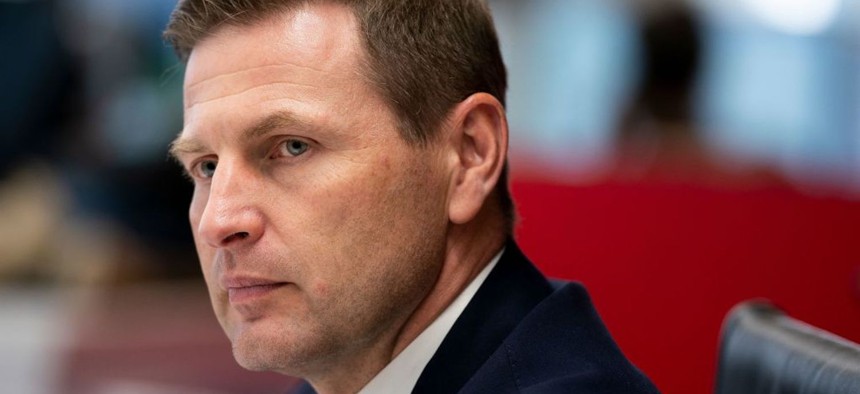
Estonian Defense Minister Hanno Pevkur speaks to reporters at the Pentagon in Washington, D.C., on October 18, 2022. Stefani Reynolds / AFP via Getty Images
Europe is already planning for what happens if Ukraine loses. It’s ugly
A newly energized Russia is already escalating grey-zone operations in Eastern Europe, says Estonia’s defense minister.
A Ukrainian loss, which could happen very soon if U.S. weapons don’t arrive, would ramp up Russian efforts to destabilize the governments of NATO countries and increase defense spending across the alliance, among other disastrous effects, Hanno Pevkur, Estonia’s Defense Minister, told reporters Friday.
When U.S. officials like President Joe Biden talk about why Ukraine matters, they rely on broad notions of democracy and the continuation of the international order—without specifically explaining what a Ukraine loss would mean for ordinary Americans. Perhaps because of this, Americans are evenly split on the question of whether the United States is doing too much for Ukraine.
Pevkur said one of the deliverables from last year’s NATO Summit in Vilnius was new battle plans for Eastern European countries should Ukraine fall.
“These plans address these different scenarios,” he said. “Of course, for obvious reasons I cannot be very specific, but I can assure you that these plans are shaped by looking at the possible Russian posture in our neighborhood.”
One of the likely consequences of a loss, he said, is a much larger and more dangerous Russian military.
“Russia has published on their plan for the reconstitution and build up their army. It says that they will have 1.5 million people in the army," including a new Army corps in the country's northwest corner, near Estonia, he said. That will mean two to seven times as many tanks, armored personnel carriers, air defense systems, etc., very close to the border of Europe, hesaid.
That military buildup will continue to put pressure on Western democracies, including the United States, to increase their defense spending, he said. “We see that the Russian war budget today is around 30 or 31% of their state budget. But this is only the military spendings. When we add to that what they are also the spending on…some other state services, which are directly linked to security, then we will see that this budget goes to 35 to 40% of the state budget.”
Russia has basically adapted its entire economy and society for war. That increases the likelihood of a direct confrontation in order to justify the buildup.
“The Russians have actually managed to really ramp up the defense industry capability, put it on a war footing. Then the unfortunate and quite dark logic arises from that: Once you've done all these things, once you’ve ramped up your economy or put it on a war footing, then there's not an easy way of going back. So they will probably have to maximize,” he said.
Pevkur said another consequence of a much larger military on the Baltic states' border is an increase in the sort of hybrid warfare attacks Russia has been escalating recently in Estonia and Moldova. He pointed to the recent Russian effort to recruit Estonian citizens to attack their own government.
That could also include new efforts to weaponize migrant routes to create multiple crises on the borders of countries like Estonia, similar to the waves of migrants Belarus and Russia began to send to the Polish border in 2021. “We know that these migrants are waiting for the better weather. They are not going away. That they are still in the region, which means that there are thousands of migrants waiting for the weather to be better to move again.”
Those efforts would be joined by attempts to undermine Western governments by supporting far right, and extreme left politicians, as well as hacking, leaking, and other disinformation campaigns, he said.
In theory, Estonia and other NATO members should be protected from these sorts of disruptive tactics and, certainly, direct military attacks. But Pevkur said Russia’s mobilization and military training efforts suggest they are more interested in preparing for an attack on a NATO nation than defending against one.
An Estonian official emphasized that Estonia and European allies remain steadfast in their support for Ukraine.
“We see from the Russian behavior at the moment that they have no feeling or no perception that NATO will attack Russia,” he said.
